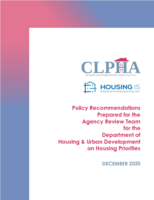Our nation is facing an unprecedented housing crisis, but there is strong bipartisan support for addressing housing supply and preservation challenges. The role of PHAs as affordable housing developers is growing, and PHAs will be crucial to increasing housing supply and preserving affordable units across the country.
Affordable housing development is a significant driver of economic growth. Congress and the second Trump Administration should expand opportunities for PHAs to boost affordable housing supply through regulatory streamlining, expanded tax credits for public-private partnerships, and new preservation tools. Opportunity Zones can also play an important role in expanding affordable housing development.
PHAs also operate and manage the majority of federal rental assistance programs in their communities and provide rent subsidies to private owners on behalf of low-income households. Funding disruptions not only put millions of households at risk for housing instability, but also cause local businesses and economies to experience significant negative impacts. Therefore, it is critical that congressionally authorized funding be available to PHAs in a timely manner so that their operations are not interrupted.
Because PHAs are key stakeholders in their local communities, it is critical that they receive the funds, flexibility, and federal support for their operations so that residents, landlords, private owners, and local economies can thrive.





